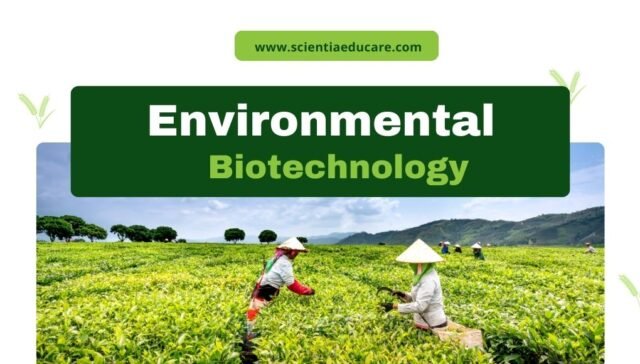Environmental Biotechnology: Sustainable Waste Management and Biodegradation Techniques
Introduction
Environmental biotechnology plays a crucial role in managing waste efficiently and promoting eco-friendly biodegradation techniques. It leverages biological processes to treat and recycle waste, ensuring environmental sustainability. With rising industrialization and urbanization, effective waste management has become a pressing issue, making environmental biotechnology a key solution for a cleaner future.
Best microbial biodegradation techniques,
Low-cost waste management solutions,
Sustainable bioremediation practices,
Effective organic waste recycling methods,
How bacteria help in waste decomposition.
What is Environmental Biotechnology?
Environmental biotechnology is a branch of biotechnology that focuses on using biological systems, such as microorganisms, enzymes, and plants, to manage waste, remediate contaminated environments, and promote sustainability.
Key Objectives:
- Reduce environmental pollution through biological waste treatment.
- Enhance biodegradation processes using microbes.
- Develop eco-friendly waste disposal methods.
- Convert organic waste into biofuels and other useful products.
Waste Management in Environmental Biotechnology
Waste management through environmental biotechnology includes a variety of techniques that focus on minimizing waste, treating hazardous substances, and converting waste into useful materials.
1. Bioremediation
Bioremediation is the process of using living organisms to remove pollutants from soil, water, and air. It includes:
- Microbial Bioremediation: Using bacteria and fungi to break down toxic compounds.
- Phytoremediation: Utilizing plants to absorb and neutralize contaminants in soil and water.
- Mycoremediation: Employing fungi to decompose organic and inorganic pollutants.
2. Composting
Composting is an organic waste management technique that converts biodegradable waste into nutrient-rich compost using microbial action. This method reduces landfill waste while enriching soil fertility.
3. Anaerobic Digestion
This process involves breaking down organic waste in the absence of oxygen, producing biogas (methane and carbon dioxide), which can be used as an alternative energy source.
4. Bioleaching
Bioleaching uses microorganisms to extract metals from waste materials, particularly electronic and industrial waste. This technique is widely used in recycling valuable metals from e-waste.
5. Biosorption
Biosorption involves using biological materials, such as algae, bacteria, and fungi, to remove heavy metals and toxic substances from wastewater.
Biodegradation: A Sustainable Approach to Waste Disposal
Biodegradation is a natural process that breaks down organic substances into simpler components using microorganisms. This is essential for reducing environmental pollution and managing waste effectively.
Types of Biodegradation:
- Aerobic Biodegradation: Requires oxygen for microorganisms to break down waste materials.
- Anaerobic Biodegradation: Occurs in oxygen-free environments, producing methane and other gases.
- Enzymatic Biodegradation: Utilizes enzymes to speed up the decomposition process.
Examples of Biodegradable Waste:
- Agricultural waste (crop residues, food scraps)
- Paper and cardboard
- Animal manure
- Biodegradable plastics
Applications of Environmental Biotechnology in Waste Management
Environmental biotechnology provides sustainable solutions for various industries and urban waste management.
1. Industrial Waste Treatment
Industries generate vast amounts of waste, including heavy metals, chemicals, and organic pollutants. Microbial consortia and genetically modified bacteria are employed to treat industrial effluents effectively.
2. Solid Waste Management
Biodegradable waste is processed through composting and anaerobic digestion, reducing landfill pressure and generating useful byproducts like fertilizers and biofuels.
3. Wastewater Treatment
Biotechnological techniques, such as activated sludge treatment and membrane bioreactors, help in treating domestic and industrial wastewater.
4. Biodegradable Plastics
Environmental biotechnology has led to the development of biodegradable plastics derived from natural polymers, such as polylactic acid (PLA) and polyhydroxyalkanoates (PHA).
Challenges in Environmental Biotechnology
Despite its benefits, environmental biotechnology faces several challenges:
- High Cost: Advanced biotechnological solutions require significant investment.
- Slow Process: Biodegradation and bioremediation take time compared to chemical treatments.
- Regulatory Issues: Strict environmental policies and approvals may slow down biotechnological implementation.
- Limited Public Awareness: People often lack knowledge about biotechnological waste management solutions.
Future Prospects of Environmental Biotechnology
The future of environmental biotechnology holds promising advancements that will revolutionize waste management and biodegradation techniques.
1. Genetic Engineering for Waste Treatment
Scientists are developing genetically modified microbes with enhanced capabilities to break down complex waste materials more efficiently.
2. Development of Advanced Biofuels
Research is focused on converting agricultural and industrial waste into second-generation and third-generation biofuels.
3. Artificial Intelligence (AI) in Waste Management
AI-driven biotechnological solutions can optimize waste segregation, treatment, and monitoring systems for improved efficiency.
Relevant Website URL Links:
- United Nations Environment Programme – Information on global environmental biotechnology efforts.
- World Health Organization – Guidelines on environmental biotechnology and waste management.
- U.S. Environmental Protection Agency – Policies on waste treatment and biodegradation.
- National Renewable Energy Laboratory – Research on biofuels and biodegradable materials.
- Biotechnology Innovation Organization – Updates on biotechnological advancements in waste management.
Further Reading:
- Biodegradation & Bioremediation by Martin Alexander
- Principles of Environmental Biotechnology by Indu Shekhar Thakur
- Microbial Biotechnology: Fundamentals and Applications
- Environmental Biotechnology Journal
- Advances in Waste Management & Recycling
Conclusion
Environmental biotechnology provides sustainable waste management and biodegradation solutions that are crucial for a cleaner and greener planet. From bioremediation to biodegradable plastics, biotechnology continues to evolve, ensuring an eco-friendly approach to handling waste. While challenges exist, advancements in genetic engineering, AI, and biofuel development indicate a promising future for environmental sustainability.
MCQs on Environmental Biotechnology: Waste Management and Biodegradation
1. What is the main goal of environmental biotechnology in waste management?
A) Increase industrial production
B) Reduce waste generation and promote sustainable disposal
C) Enhance fossil fuel usage
D) Replace renewable energy sources
✅ Correct Answer: B) Reduce waste generation and promote sustainable disposal
Explanation: Environmental biotechnology focuses on minimizing waste production and utilizing biological methods like microbial degradation to treat waste sustainably.
2. Which microorganisms are commonly used in bioremediation?
A) Viruses
B) Bacteria and fungi
C) Algae
D) Protozoa
✅ Correct Answer: B) Bacteria and fungi
Explanation: Bacteria (e.g., Pseudomonas, Bacillus) and fungi (e.g., Aspergillus, Penicillium) are widely used in bioremediation due to their ability to degrade pollutants.
3. Which of the following is an example of in situ bioremediation?
A) Composting
B) Phytoremediation
C) Landfilling
D) Incineration
✅ Correct Answer: B) Phytoremediation
Explanation: Phytoremediation is an in situ bioremediation technique where plants absorb and degrade contaminants from soil and water.
4. What is the primary advantage of microbial biodegradation?
A) It requires high energy input
B) It is cost-effective and eco-friendly
C) It is faster than chemical degradation
D) It increases soil toxicity
✅ Correct Answer: B) It is cost-effective and eco-friendly
Explanation: Microbial biodegradation is an environmentally friendly and cost-effective method for breaking down pollutants using naturally occurring microorganisms.
5. What is the term for microorganisms that thrive in extreme polluted environments?
A) Mesophiles
B) Extremophiles
C) Halophiles
D) Thermophiles
✅ Correct Answer: B) Extremophiles
Explanation: Extremophiles can survive in highly contaminated environments, making them useful for biodegradation in harsh conditions.
6. Which of the following is NOT a bioremediation strategy?
A) Bioaugmentation
B) Biostimulation
C) Biocorrosion
D) Composting
✅ Correct Answer: C) Biocorrosion
Explanation: Biocorrosion refers to the deterioration of materials due to microbial activity, whereas the other options are bioremediation strategies.
7. What is the main role of fungi in biodegradation?
A) Photosynthesis
B) Breakdown of complex organic compounds
C) Production of oxygen
D) Nitrogen fixation
✅ Correct Answer: B) Breakdown of complex organic compounds
Explanation: Fungi secrete extracellular enzymes that break down lignin, cellulose, and other complex organic materials in waste.
8. Which gas is a major byproduct of anaerobic digestion?
A) Oxygen
B) Methane
C) Hydrogen
D) Carbon monoxide
✅ Correct Answer: B) Methane
Explanation: Anaerobic digestion produces methane as a byproduct, which can be used as a renewable energy source.
9. What is the term for the use of genetically engineered microbes for pollution control?
A) Natural attenuation
B) Bioaugmentation
C) Biostimulation
D) Phytoremediation
✅ Correct Answer: B) Bioaugmentation
Explanation: Bioaugmentation involves introducing genetically modified microbes to enhance biodegradation of pollutants.
10. What is the key process in composting?
A) Aerobic microbial degradation
B) Anaerobic oxidation
C) Photochemical reaction
D) Chemical incineration
✅ Correct Answer: A) Aerobic microbial degradation
Explanation: Composting is an aerobic process where microbes decompose organic waste into nutrient-rich compost.














